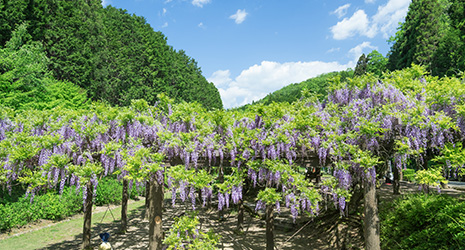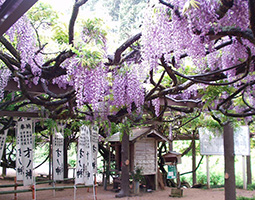April 2022
- English
- 日本語
A Silky Wisteria Said To Be Over 1,200 Years Old

Sainokami no Fuji viewed from above 
The entwined trunks and branches of Sainokami no Fuji

Purple flower clusters cascade over the trellis 
A small shrine (hokora) has been established under the ancient tree

Fukuchiyama City in Kyoto Prefecture is home to a silky wisteria called Sainokami no Fuji which is estimated to be over 1,200 years old. From late April to early May, its purple flowers cascading over a wooden trellis delight onlookers with their elegance and grace.

Masses of purple flower clusters cascade over a large trellis, giving off a sweet fragrance. Visitors gather beneath this “ceiling” of flowers to delight in the swaying of the elegant purple clusters of flowers in the faintest of breezes, referred to by the Japanese since ancient times as fuji-nami, or wisteria waves. This scene can be observed every spring under a yamafuji (a variety of silky wisteria) called Sainokami no Fuji that grows in Fukuchiyama City, Kyoto Prefecture.
The Sainokami no Fuji is estimated to be 1,200 years old and is designated a natural monument by Kyoto Prefecture. Six trunks of varying sizes, including one standing approximately 3 meters tall and measuring 180 centimeters around its circumference, are entwined and spread their branches over a trellis measuring 30 meters square.

The silky wisteria is a species of fuji (wisteria) endemic to Japan, a flowering vine of the pea family native to mountainous areas in almost half of the west of the country. The tendrils of the silky wisteria grow anticlockwise and its flower clusters are generally 10 to 20 centimeters long. The flower clusters of the Sainokami no Fuji are longer, measuring 30 to 40 centimeters, and most years look at their best from late April to early May.
An official at the Fukuchiyama City Hall Oe Branch, which manages the Sainokami no Fuji, says, “The trellis has been made low so visitors can reach out and touch the flower clusters. The spectacular sight of the flowers cascading over the large trellis has a healing effect.”

Makura no soshi (The Pillow Book)*, a collection of observations written in the middle of the Heian period (late 8th century to late 12th century) when court culture flourished in Kyoto, mentions wisteria as an example of something “noble” that was admired by the aristocracy. In Makura no soshi, wisteria are described thus: “The clusters of deep purple blooms cascading gracefully down are truly splendid.” The Sainokami no Fuji flower clusters, then, evoke an ideal espoused by the aristocracy of the time.
“I heard that an elementary school student once wrote in her composition, ‘The Sainokami no Fuji is the flower of our heart.’ With its long history of over 1,200 years, the Sainokami no Fuji has played a role in passing down the Japanese people’s affection for flowers to the next generation,” says the local government official.
Still going strong at 1,200 years old, the Sainokami no Fuji is a noble tree that continues to nurture Japanese people’s love for flowers.
* A collection of observations by Sei Shonagon, author and a lady at the Imperial Court of Japan (born in the second half of the 10th century and died in the middle of the first half of the 11th century).

